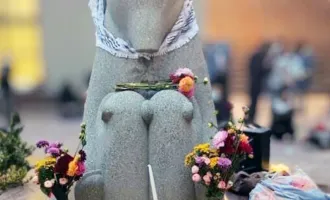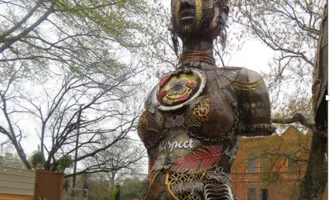This Date in UCSF History: Beliefs and customs
Originally published on May 4, 1979. Delivery of quality health care not only depends on the technical medical knowledge and skills of the health professional, but also on the patient’s perceptions of what is health and disease.
This raises a unique problem for Asian-Americans who come from or believe in a medical system completely different from Western society.
This is a brief attempt to explore some of the cultural health attitudes of Asian Americans, in order to help the health care provider better understand and deal with the Asian American patient. Asians, or more broadly Pacific/Asians, refers to individuals of Asian or Pacific Island ancestry.
Most of the information that follows is based on Dr. Kwan’s and several other authors’ experiences in working with Chinese Americans. This is an adequate model for the purposes of this brief article, because Chinese influence pervades most Asian health traditions.
(The equivalent of acupuncture and acupressure in Japan is shiatzu and Ryodoraku, and the Filipino Espiritas “temple healers” perform spiritual healing similar to that found in China.)
Because of the persistent aggregation of Asians in urban communities, the pressures exerted by the more traditional elderly, and the recent influx of Asian immigrants, much of these traditional Asian health attitudes and practices still remain intact.
Beliefs Much of Chinese medical beliefs center around the principle of Yin and Yang.
The Yin represents cold, darkness, and negative. The Yang represents hot, light, and positive.
Health is seen as the balance of these two forces within the body. Disease occurs when this balance is disturbed.
The Chinese approach to health is mainly preventative, in contrast to Western medicine which is crisis oriented.
Traditionally, a healthy patient went to the physician for a check-up or “tune-up.”
The physician would tell the patient what to eat, how to exercise and how to meditate in order to keep the body healthy and the Yin and Yang in balance.
If the physician failed and the patient became sick, then the cease to pay the physician and the treatment was free of charge.
Hot or Cold
Certain diseases are perceived as “hot” or “cold.” For example, cancer is a “cold” disease.
If a Chinese child is diagnosed as having leukemia, the physician may have to reassure the mother that the cancer was not due to too many “cold” foods in the diet.
Whether a food is “cold” or “hot” does not depend upon the temperature at which the food is prepared but on the experience of Chinese physicians over many generations. Sometimes the “hot and cold” theory may work to the physician’s advantage.
For example, a cold with a fever and sore throat is perceived as a “hot” disease.
The physician can recommend that the patient drink lots of juices and vegetable soup which are considered “cold” foods in order to help restore the body balance. Unfortunately, this can be a double-edged sword, because many Chinese believe that a child may get a cold (a “hot” disease) because of exposure to too many “cold” elements (the body responds by becoming “hot.”)
Thus the parents will bundle the child up to protect it from the “cold” elements when in fact this may serve to further exacerbate the fever. Yet, at the same time the parents can be convinced that giving “cold” foods will help to dissipate the fever.
This confusion in cause and effect and the implications for treatment points out the difficulty in generalizing the Yin-Yang theory, because it is subject to individual interpretation. However, it is still important for the health professional to realize that the Asian American patient views disease in terms of balance between the Yin and Yang.
Herbs Upwards of 90 percent of Chinese in Chinatown are taking Eastern herbs and medicines for their illnesses in addition to western medicine.
Since the ingredients of many of these herbs are unknown and drug interactions are possible, it is imperative for the physician to ask if the patient is taking any herbs or Eastern medications.
If the medications are benign then it is okay to let the patient continue taking them.
However, as is most often the case, if the physician does not know what is in the herbs, then it is safest to explain that there may be drug interactions and that it would be best to take the herbs.
(Ginseng, considered a panacea, has dammarenetriol glycosides and Ma Haung or Chinese Ephedra, used in pulmonary disease, has ephodrine as the main component; both are contraindicated in hypertension.)
Most Asian American patients will comply if they understand the explanation. When a Chinese goes to see a herbalist, they almost always get some sort of medication and they are told one or just a few doses should be enough.
This sort of tradition presents difficulties in western practice of medicine.
First, the Chinese patient will frequently insist on some sort of medications for a viral flu or other illnesses where there is no specific pharmacologic therapy. (In Hong Kong injections of antibiotics are frequently given to a patient with a viral flu.)
If the physician does not prescribe anything without an adequate explanation, this misunderstanding may cause the patient to lose confidence in the physician and to seek another doctor or an herbalist.
Secondly, a Chinese patient may find it difficult to comprehend why Western doctors give so many pills to be taken over a long period of time, leading to problems with compliance.
This problem can only be overcome by patiently explaining the reasons for particular therapies or drug regimens.
Surgery Another interesting belief which may be found among elderly Chinese is that surgery, no matter how small, despoils the soul and prevents the soul from entering heaven.
Physicians must recognize that this may play an important role in the patient’s decision making process in regards to surgery.
Finally, one interesting common health practice among Southeast Asian immigrants, new and old, is the “pinching treatment” or “qua tsa” for the treatment of fever.
A coin or a spoon, dipped in vegetable or cooking oil is used to stroke or scrape the skin of the back, the back of the neck, or the bridge of the nose.
This is done so vigorously that it produces bruising and ecchymosis, and it is thought that this will cause the fever to leave the body.
Many physicians have seen these marks on children and have accused the well-intentioned parent of child abuse.
The list of Asian medical practices, herbs and beliefs is endless.
Indeed it is as large as the number of individual Asian-American patients, each with their own interpretation and perceptions.
This article only accounts some of the health attitudes and practices common among Asians. They are by no means universal because Asians are not a homogeneous race or society.
Furthermore, as the younger generations of Asian Americans become more educated and assimilated, some of these health attitudes will be left behind.
Thus in applying some of this knowledge of traditional Asian health attitudes, the health professional must be careful to understand the socio-cultural background of the Asian American patient in order to avoid undue stereotyping and misunderstanding.
Dr. Tina Kwan is a Pediatrician at the North East Medical Services in San Francisco Chinatown. She was born in China, and she immigrated to this country when she was 17.


